BY LETTER
Asteroids and Asteroid Mining
Technology > Application > Manufacturing
Technology > Application > Materials Technology
Culture and Society > Economics > Occupations, Avocations, and Work
Technology > Application > Materials Technology
Culture and Society > Economics > Occupations, Avocations, and Work
The process of extracting useful minerals and other substances from asteroids | |
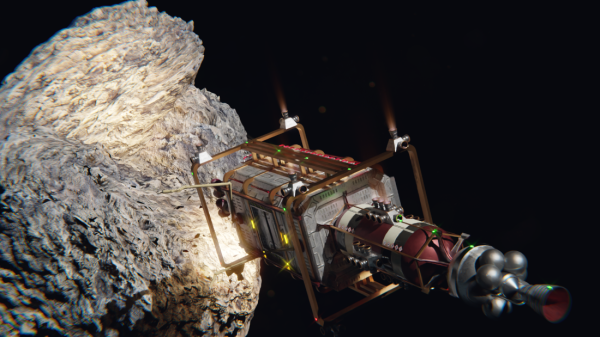 Image from Copyright Lilly Harper | |
| A Rockhopper mining ship approaches an asteroid | |
In a burst of magnetic acceleration and a shimmer of laser light a thousand seeds shot from the habitat. Each one comprised of a carefully measured protective coating around a soft, semi-organic core. After two weeks climbing the gravity well the fist-sized cloud impacted the target.
Not all of them survived, but that was to be expected. In this case quality had diminishing returns that quantity lacked. From those seeds that didn't deflect into space or were totally destroyed upon lithobreaking, stirrings of artificial life began.
It took a few months to notice any change. Energy in those tiny craters was not abundant. But eventually even an unaugmented eye would notice the dark, moss like growth upon the asteroid. Solar fibers soaked up stray photons, powering newly hatched synsects to spread layers of smartgel. The process was slow at first, but not too long after first sighting an observer would find the entire rock wrapped in film.
The fronds came next. Long, spindly trees of black leaves stretched over kilometers by the asteroid's slow spin. With a thousand fold increase in power the real work could begin. Focusing on the infrared an observer would note the increasing build-up of heat. Lines of fresh material, dug from deep within by tunneling bots, were squashed into blisters upon the envelop. In baths of ice-mined water and molecular machines precious resources were separated from waste.
Eventually the final stage began. Fruit budded on the trees. Slick-skinned coconuts packed with the refined products of the blisters. In puffs of gas and shivers of branches ten thousand pods were released. In a lazy arc they escaped the ghostly pull of the rock, new fruit growing in their place on the slowly shrinking celestial body. In a matter of months their artificially evolved bodies would meet the mother hab. The first reaping of a simple sewing.
Nanobiotechnology: The harvest collection
Despite their small size and comparatively sparse distribution, asteroids are the most common source of raw material within Terragen civilization. Readily accessed and with negligible gravity, they can be mined and transported more easily than a similar volume of mass extracted from a planetary body. While asteroids can be found freely orbiting almost anywhere, gravitational interactions tend to collect them into denser groupings such as asteroid belts or planetary rings.
In a young solar system, gas and dust will come together to form the small meteoroids that, billions of years later, still rain down on all planets. And these meteoroids will come together and form asteroidal bodies. Most of these, in turn, will continue on to create planetoids, and eventually full fledged planets. But there are regions where asteroids might survive in their pristine form. The gravitational interactions between giant planets and central suns can conspire to prevent a planet from coalescing, and thus an asteroid belt will be formed, as was one between the orbits of Mars and Jupiter in the Solar System. Further out in space, there will remain the almost untouched reserve of frozen cometary bodies in what is called the Oort Cloud. And of course, asteroidal bodies of all types will be nudged into wildly eccentric, often unstable orbits that reach throughout a solar system.
Classification of Asteroids
Asteroids are divided into various classes, each of which is different in nature and value. Two classification systems are primarily used; the Non-Luminary World Classification Scheme (NoLWoCS), and the Extended World Classification System (EWoCS).Asteroid Mining
Because of the ease with which resources can be accessed, and habitats created, asteroids are very important in the development of new solar systems, and are frequently the first part of a solar system to be settled. The nature of any general group of asteroids, including but not limited to their location, orbit, consistency, density, and mass, along with the inhabiting civilizations' potential intentions, desires, culture, and technology, leads to innumerable ways that the material might be extracted and utilized. Despite this, there are several general methods which deal with the advantages and disadvantages that asteroids offer.One main advantage of asteroids is their inherent orbital momentum and low mass, making extracting their resources or moving them to a different orbit a trivial feat for even midtech civilizations. The main disadvantages of asteroid mining are the challenges associated with the debris which collects naturally on their surface as well as that generated by the mining process. Even small asteroids possess layers of loose surface material ranging from particulate dust to large boulders, held together delicately in an otherwise undisturbed micro-gravity environment. The escape velocity of these bodies can be fractions of a kilometer per hour, meaning any contact with their surface, or any changes to their rotational momentum, will result in clouds of debris which can escape and float away, enter orbit, or fall back to the surface. Asteroids also tend to have irregular rotation, tumbling through space about random axes. This rotation must be stopped or matched in order to have easy access to their material, however the process of slowing down the rotation may result in parts of the surface flying off into space.
This issue is usually solved by enveloping the asteroid before material extraction, a method inherent to the process regardless of surface debris as it can ensure no desired material is lost to space. If the target is located initially in an area intended to receive regular traffic, such as a waypoint for a larger mining operation, it is likely to be completely enclosed prior to mining operations. Mid-tech mining units suited to this task utilize a bag which opens and closes mechanically, while higher-tech versions consist of utility fog able to form surface-area efficient sealed environments around the body and perform the material extraction itself. The debris issue can also simply be ignored; for asteroids far from other infrastructure, it may not be detrimental to lose the debris within a localized area, as it will continue more or less in the same orbit it always had. If the asteroid is to be sent to another location, the debris may be intentionally cast off before departure.
For larger bodies, extraction may be done from the inside out. Small access ports are drilled within small bubbles on the surface, leading to the interior where the asteroid is hollowed from the inside out. Inhabitants may live on their surface, or utilize the interior to create numerous types of enclosed habitats. The material on the surface will still be disturbed and must be collected or cast off.
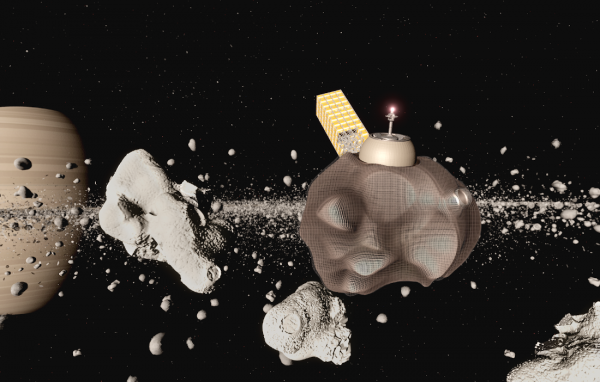 Image from Alex Mulvey | |
| A neumann swarm envelopes an asteroid-sized object within a planet's rings | |
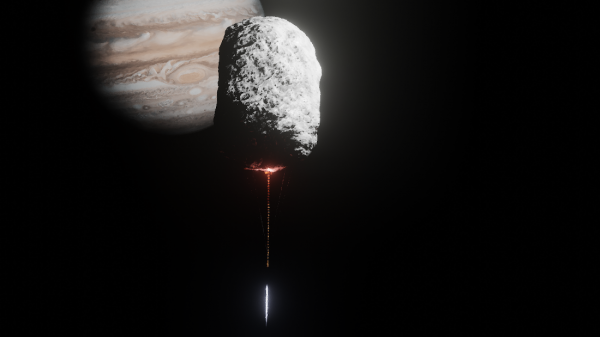 Image from Copyright Lilly Harper | |
| A mass driver attached to an asteroid can be used to deliver mined materials to a distant location, and may also be used to accelerate the asteroid itself. | |
The main challenges in Asteroid Mining
The main difficulties facing an asteroid miner include- A lack of atmosphere for aerobraking; landing on Earth is made easier because of this useful deceleration aid.
- Minimal Oberth Effect making it expensive in delta-vee to decelerate into orbit round an asteroid,
- Irregular shape, making any orbit around an asteroid chaotic and potentially dangerous ( try plotting a close orbit around Kleopatra without hitting one or other of the protuding ends).
- Rapid rotation- for asteroids smaller than 100m the rotation may be fast enough that you could be thrown off the surface.
- Tumbling- many asteroids have unstable rotation (i.e. their period and axis of rotation vary over time), which also makes it difficult to land.
Envelope Mining
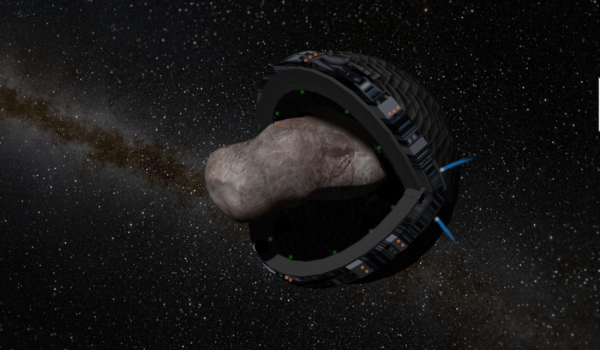 Image from Steve Bowers | |
| A Pacman miner manoeuvring around an asteroid, after matching its rotation. The spherical bag will envelop the object and will become an enclosed environment allowing mining activities to be carried out with minimal losses | |
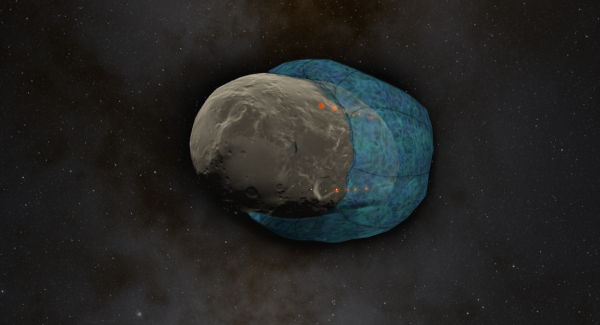 Image from Steve Bowers | |
| This envelope miner system encases the asteroid in smart gel, which refines the ores and contains any volatile gases | |
Optical Mining
Another process which is often used is optical mining: using concentrated sunlight to break up asteroids. This begins with enclosing a target asteroid in a bag attached to the mining ship. Next, sunlight is concentrated onto the asteroid using a system of mirrors, fracturing it and releasing volatiles such as water. The volatiles are then collected and frozen for storage. The remaining solid slag may be discarded or retained for further processing, depending on the capabilities of the individual mining ship.Not all asteroids are amenable to optical mining: this technique is best used on asteroids that are relatively small and have a high water content.
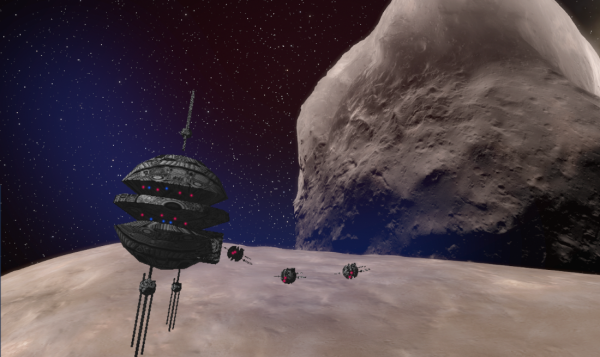 Image from Steve Bowers | |
| Neumann vecs replicating near Dactyl. Many von Neumann self-replicating systems replicate by producing miniature copies of themselves which then grow larger over time | |
Occasionally an asteroid or asteroid belt will be discovered with an unusual composition that makes it valuable for scientific or even aesthetic purposes. Even more rare, the hulk of an ancient ship or a neumann may be recovered, often centuries or millenia old, drifting in a belt. The salvage rights of such a find can make a belter rich for a life. Rarest and most prized of all are alien artifacts, although the possibility of such a find is more a part of myth and legend than pragmatic reality.
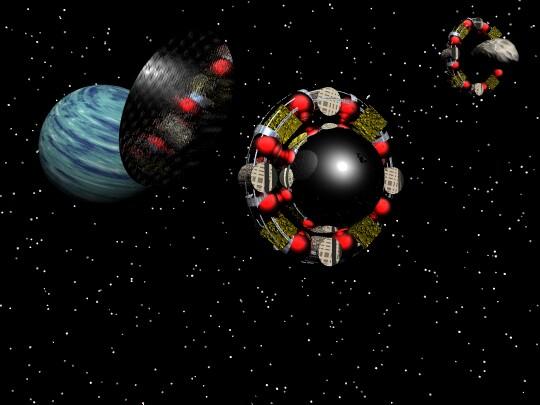 Image from Todd Drashner |
Related Articles
- A-Brain, Asteroid Brain
- Asteroid Belt
- Asteroid Defense (Game)
- Belter
- Centaurian Type Asteroid
- Ceres - The Early Years
- Gravity Tug
- Mineral - Text by M. Alan Kazlev
Any naturally-occurring solid of definite chemical composition whose atoms usually form a regular pattern. Artificial or entirely biogenic solids, or amorphous materials like glass, are not considered minerals. Common examples of minerals on the surface of a Gaian type planet are quartz, various feldspars, calcite, or olivine. In the outer reaches of a solar system ice is one of the most abundant minerals on the surface. Rocks may be composed of one or many different kinds of minerals. - Mining
- Neumann (Von Neumann Self-Replicating Systems)
- Pacman Miner
- Planetesimal - Text by M. Alan Kazlev
One of the small bodies in a solar nebula, from which protoplanets may form. They usually range from micrometers to kilometers in diameter. On the larger scale, planetesimals shade into asteroidal class planetary type bodies. - Planetoid Class
- Trojan Asteroids - Text by M. Alan Kazlev
Asteroids caught near the Lagrangian points in a planet's orbit, 60° ahead of and 60° behind the planet. The original Trojans were connected to Jupiter's orbit, but the term is used to designate asteroids or other similar bodies in a relation to any large planet. - Vesta
- Vestian Type Planetoid
Appears in Topics
Development Notes
Text by Alex Mulvey, M. Alan Kazlev, Tardigrade and Steve Bowers
Snapshot by Ryan_B, article updated by Todd Drashner
Initially published on 08 October 2001.
Revised Feb 2021 and updated June 2022
Snapshot by Ryan_B, article updated by Todd Drashner
Initially published on 08 October 2001.
Revised Feb 2021 and updated June 2022
Additional Information
Image 'Rockhopper Ship' copyright by Lilly Harper used with permission. Please contact her for conditions of re-use.






